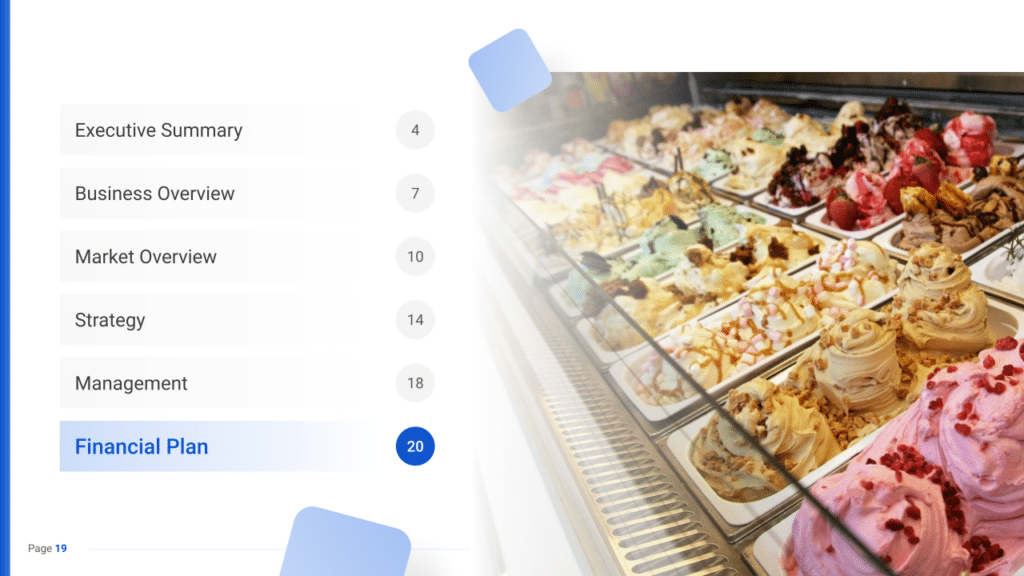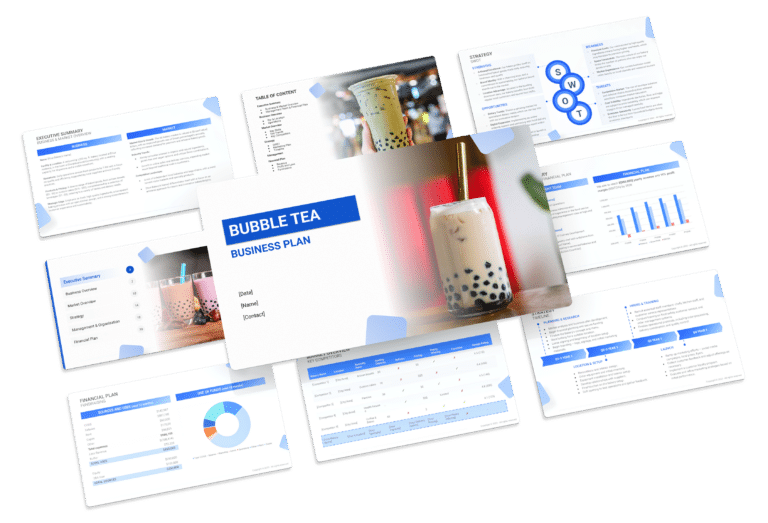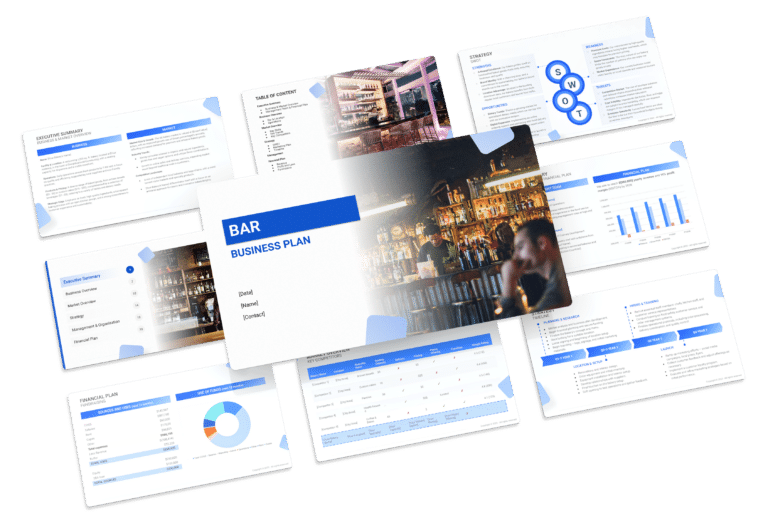Ice Cream Shop Business Plan Template & PDF Example
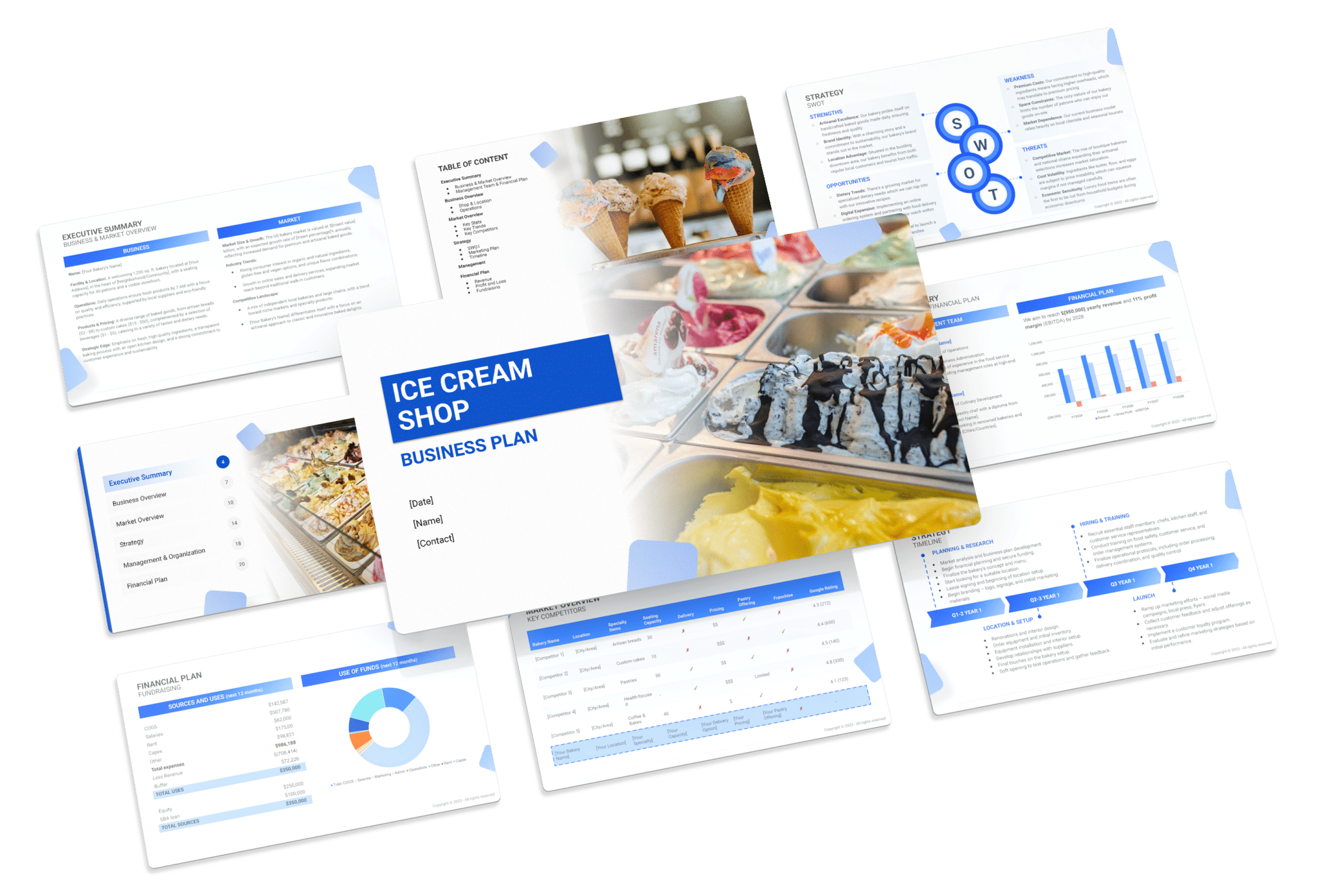
Creating a comprehensive business plan is crucial for launching and running a successful ice cream shop. This plan serves as your roadmap, detailing your vision, operational strategies, and financial plan. It helps establish your ice cream shop’s identity, navigate the competitive market, and secure funding for growth.
This article not only breaks down the critical components of an ice cream shop business plan, but also provides an example of a business plan to help you craft your own.
Whether you’re an experienced entrepreneur or new to the food&beverage industry, this guide, complete with a business plan example, lays the groundwork for turning your ice cream shop concept into reality. Let’s dive in!
The Plan
Our ice cream shop business plan is tailored to cover all essential aspects for a well-rounded strategy. It details the shop’s operations, marketing initiatives, market environment, competitors, leadership structure, and financial projections.
- Executive Summary: A quick overview of your Ice Cream Shop’s idea, market potential, the team behind it, and financial strategy.
- Business Overview: Short insights on what your Ice Cream Shop offers and how it operates:
- Ice Cream Shop & Location: Describes the shop’s design and prime location for attracting ice cream lovers.
- Supply & Operations: Explains the supply chain, ice cream-making process, and day-to-day operations.
- Market Overview: Looks at the ice cream industry, spotlighting your shop’s niche:
- Key Stats: Presents the size and growth of the ice cream market.
- Key Trends: Points out trends like artisanal flavors and health-conscious options.
- Key Competitors: Identifies competitors and what makes your shop unique.
- Strategy: Lays out your plan for success and customer engagement:
- SWOT: Brief strengths, weaknesses, opportunities, and threats analysis.
- Marketing Plan: Short strategies for getting and keeping customers.
- Timeline: Major milestones from start-up to the first year’s end.
- Management: Gives info on the team running the shop and their responsibilities.
- Financial Plan: Forecasts finances over 5 years, covering income, expenses, and profits.

Executive Summary
The Executive Summary introduces your ice cream shop’s business plan, providing a succinct overview of your shop and its offerings. It should describe your market positioning, the variety of ice cream flavors and related products you offer, its location, size, and a summary of daily operations.
This section should also discuss how your ice cream shop will fit into the local community, including the number of direct competitors in the vicinity, identifying who they are, along with your shop’s unique selling points that set it apart from these competitors.
Additionally, it should include information about the management and co-founding team, outlining their roles and contributions to the shop’s success. Furthermore, a summary of your financial projections, including revenue and profits over the next five years, should be included here to offer a comprehensive view of your ice cream shop’s financial strategy.
Ice Cream Shop Business Plan Executive Summary Example

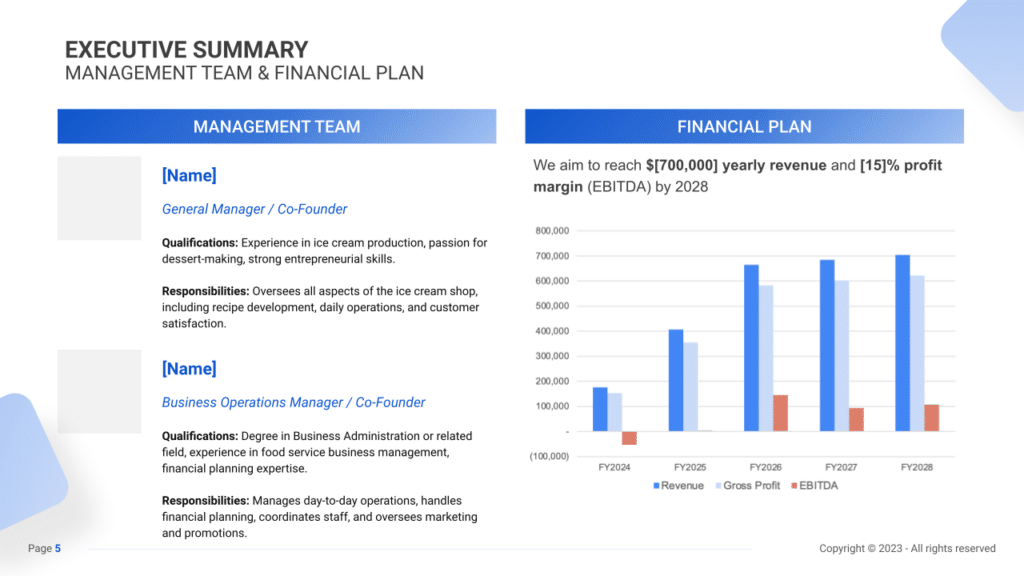
Business Overview
The business overview section in your executive summary should present a succinct description of your ice cream shop. This includes its name, location, and an overview of daily operations that set the stage for its distinctive features.
A crucial aspect is your unique selling proposition (USP), which distinguishes your ice cream shop from competitors. Whether it’s your focus on artisanal production methods, offering unique seasonal flavors, or promoting sustainability, your USP is pivotal in capturing the audience’s attention and showcasing the distinctive value your business brings to the market.
Example:
For instance, “Scoops & Swirls,” situated in the heart of downtown Oakwood, occupies a 1,800 sq. ft. space on Market Street. Operating from noon to 10 p.m., it offers a plethora of ice cream flavors ranging from timeless classics like creamy vanilla to inventive options like avocado-lime sorbet. The shop’s USP lies in its commitment to creating indulgent, handcrafted flavors using locally sourced, organic ingredients, appealing to health-conscious consumers seeking a guilt-free treat.
Market Overview
An in-depth understanding and portrayal of the market’s size, growth trends, and industry dynamics form the crux of the market analysis. This segment should highlight the potential of the ice cream market, supported by relevant data such as market value and growth rates.
Discussing industry trends, such as the growing demand for unique and artisanal flavors or eco-friendly packaging, offers insight into the evolving landscape and where your ice cream shop fits within it. Additionally, identifying key competitors and elucidating how your shop stands out in this competitive environment is paramount.
Example:
Within the US ice cream shop industry, boasting a substantial value of $1.9 billion in 2023, with an anticipated growth rate of +4.4% annually over the 2023-2029 period and accommodates approximately 17,000 ice cream shops, Scoops & Swirls distinguishes itself by championing locally sourced, organic ingredients. While competing with established national chains and local dessert parlors, its commitment to sustainability and artisanal craftsmanship sets it apart, catering to the environmentally conscious consumer base seeking premium, ethically sourced indulgences.
Management Team
Highlighting the background and expertise of the management team is crucial. Emphasize the key qualifications and experiences of team members, showcasing their expertise and underscoring their contributions to the shop’s success.
Example:
At Scoops & Swirls, the management team, led by co-founders Anna Garcia and David Chen, leverages a combined experience of over 20 years in the food and hospitality industry. Anna brings expertise in business administration and marketing, while David’s background in culinary arts and supply chain management ensures excellence in product quality and sourcing, providing a solid foundation for the shop’s success.
Financial Plan
The financial plan overview should provide a concise summary of your financial objectives and projections, including revenue targets and profit margins, offering a clear trajectory of your ice cream shop’s financial journey.
Example:
Scoops & Swirls aims for annual revenue of $700,000 and a robust 15% profit margin (EBITDA) by the year 2028. The financial strategy involves an initial investment in premium ingredients and sustainable packaging, coupled with robust marketing initiatives leveraging social media and community events, positioning the shop for sustained growth and profitability within the local market.
Business Overview
For an Ice Cream Shop, the Business Overview section can be succinctly divided into 2 main parts:
Ice Cream Shop & Location
Briefly describe the ice cream shop’s physical setting, emphasizing its design, ambiance, and the welcoming atmosphere it creates for customers. Mention the shop’s location, highlighting its accessibility and convenience for customers, such as its proximity to popular community spots or ease of parking. Explain why this location is beneficial for attracting your target clientele.
Supply & Operations
Detail the variety of ice cream flavors and related products offered, from classic favorites to unique, artisanal creations. Outline your sourcing strategy, ensuring it reflects a commitment to quality and, where possible, local sourcing.
Explain your operations, including how ice cream is stored, served, and the measures in place to maintain the highest standards of hygiene and customer satisfaction. Highlight any special offerings, seasonal flavors, or loyalty programs that provide added value to your customers, encouraging repeat visits and customer loyalty.

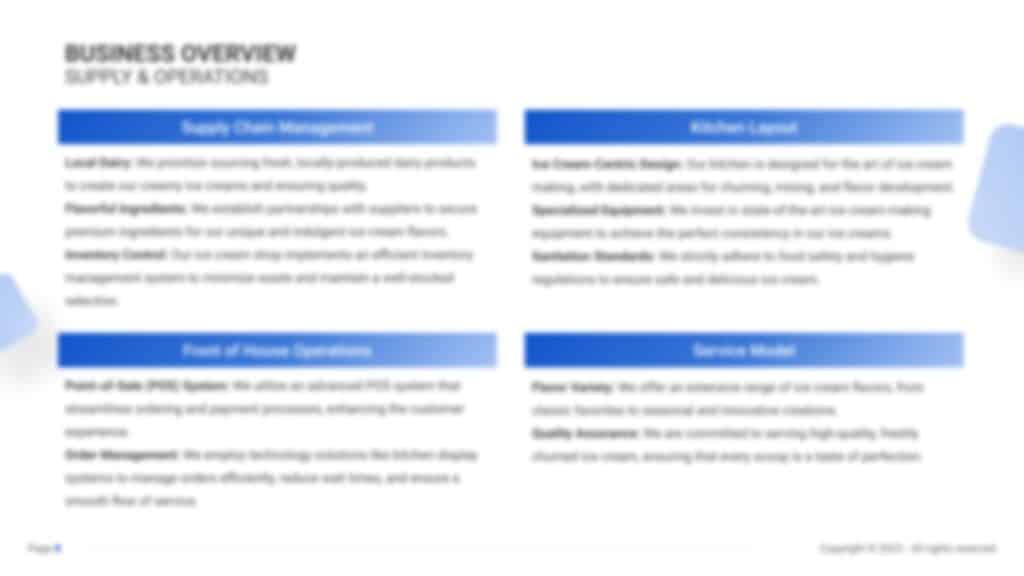
Market Overview
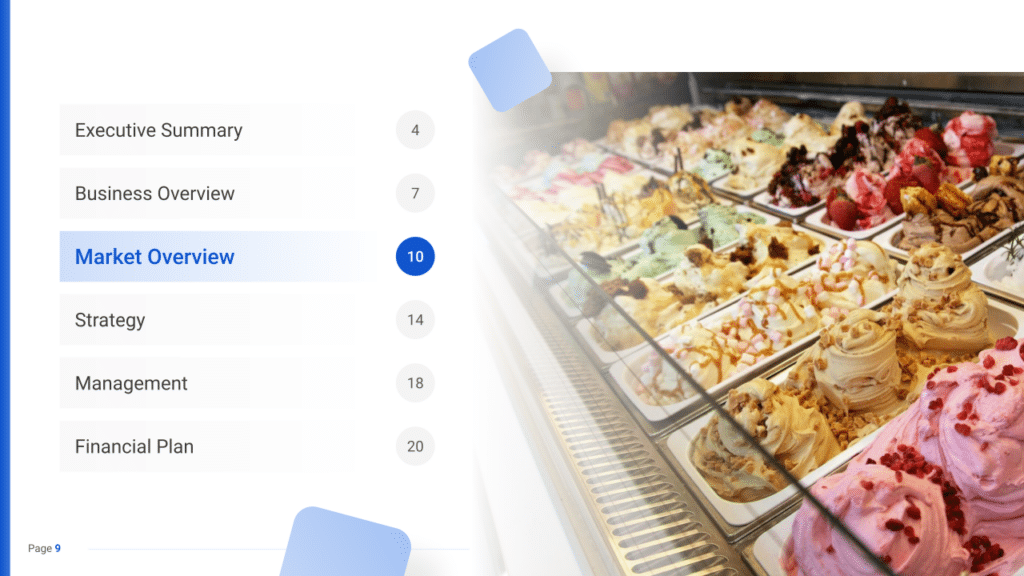
Industry size & growth
In the Market Overview of your ice cream shop business plan, start by examining the size of the ice cream industry and its growth potential. This analysis is crucial for understanding the market’s breadth and identifying opportunities for expansion.
Key market trends
Proceed to discuss recent market trends, such as the increasing consumer interest in artisanal and gourmet ice cream, the demand for a wide range of flavors including exotic and locally inspired ones, and the growing popularity of health-conscious options like dairy-free and low-sugar ice creams.
For example, highlight the trend towards customization and personalization in ice cream servings, as well as the incorporation of organic and sustainable ingredients.
Competitive Landscape
A competitive analysis is not just a tool for gauging the position of your ice cream shop in the market and its key competitors; it’s also a fundamental component of your business plan. This analysis helps identify your ice cream shop’s unique selling points, essential for differentiating your business in a competitive market.
In addition, competitive analysis is integral in laying a solid foundation for your business plan. By examining various operational aspects of your competitors, you gain valuable information that ensures your business plan is robust, informed, and tailored to succeed in the current market environment.
Identifying Ice Cream Shop Competitors
Commence your competitive analysis by identifying the primary competitors in your area. Direct competitors include other ice cream parlors offering similar products and experiences. This encompasses local artisanal ice cream shops, national chains, and dessert establishments serving ice cream.
Don’t overlook indirect competitors, such as frozen yogurt shops or gelaterias, which may not sell traditional ice cream but cater to a similar customer base seeking frozen treats.
Utilize online resources like Google Maps, Yelp, or social media platforms to gain insights into customer reviews, ratings, and competitor locations. For instance, if “Sweet Swirls Gelato” receives praise for its exotic flavors and creamy texture consistently, this denotes a key strength to consider.

Ice Cream Shop Competitors’ Strategies
Understanding the strategies adopted by your competitors involves diving deep into various dimensions of their business operations:
- Ice Cream Offerings: Scrutinize the range of flavors, toppings, and unique items. If “Healthy Scoops” is gaining traction with its dairy-free and low-sugar options, it signals a burgeoning market preference for healthier frozen treats.
- Customer Experience: Evaluate the in-store ambiance, quality of customer service, and overall experience provided. A store like “Chill Haven” might carve its niche with vibrant décor and interactive customer service, potentially attracting a specific clientele seeking such experiences.
- Pricing Strategy: Conduct a comparative analysis of pricing structures against competitors. Are you positioned as an economical choice akin to “Budget Cones,” or do you align with premium offerings like “Gourmet Gelato”?
- Marketing Tactics: Observe the marketing approaches adopted by competitors. Do they heavily rely on social media engagement, collaborate with local influencers, or organize distinctive events to entice customers?
- Innovation and Specialization: Consider any distinctive selling points or specialized techniques. Perhaps a store like “Retro Freeze” sets itself apart with vintage-themed presentations or emphasizes the use of locally sourced, artisanal ingredients.
What’s Your Ice Cream Shop’s Value Proposition?
Reflect deeply on what makes your ice cream shop stand out in a crowded market. This could manifest through signature flavors exclusive to your shop, a unique customization concept allowing customers to create personalized treats or an unwavering emphasis on using organic ingredients sourced directly from local farms.
Identify market gaps through customer feedback and emerging trends. For instance, the escalating demand for plant-based ice creams could present a lucrative opportunity if competitors have yet to explore or address this burgeoning segment.
Tailor strategies according to your location. An ice cream shop situated in a tourist-heavy area might emphasize novelty items and cater to diverse tastes, while one in a suburban neighborhood could concentrate on fostering family-friendly experiences and community engagement initiatives.
Strategy

SWOT
First, conduct a SWOT analysis for the ice cream shop, highlighting Strengths (such as unique flavor offerings and a prime location), Weaknesses (including seasonal fluctuations in demand or limited indoor seating), Opportunities (for example, a growing interest in artisanal and gourmet ice cream), and Threats (such as new competitors entering the market or changes in health trends that may impact ice cream consumption).

Marketing Plan
Next, develop a marketing strategy that outlines how to attract and retain customers through innovative flavor launches, special promotions, an engaging online presence, and participation in local events and festivals.
Marketing Channels
Employing various marketing channels is crucial for increasing brand awareness and drawing customers to your ice cream shop.
Digital Marketing
Utilize online platforms:
- Social Media Engagement: Engage with your audience on platforms like Instagram, showcasing enticing visuals of your ice cream creations, behind-the-scenes content, and customer testimonials. Leverage Facebook for community engagement and Twitter for real-time updates and promotions.
- Email Marketing: Develop an email list offering exclusive discounts or insider updates. Send newsletters featuring flavor launches, special promotions, and events at your shop.
- Website and SEO: Maintain an informative, user-friendly website highlighting your menu, shop location, hours, and an engaging blog with ice cream recipes, fun facts, or customer stories. Optimize for local SEO to enhance visibility.
Local Advertising
Connect with the local community:
- Local Outreach: Distribute visually appealing flyers in high-traffic areas, collaborate with nearby businesses for cross-promotions, and sponsor community events or fundraisers.
- Partnerships: Forge partnerships with nearby cafes, restaurants, or event organizers to showcase your ice cream or create joint offerings.
Promotional Activities
Entice customers with compelling offers:
- Special Deals: Crafting compelling offers involves aligning them with seasons, festivities, or local events. For instance, during summer, launching a ‘Sunshine Sorbet Series’ might capture attention while offering ‘Back-to-School Bundles’ in autumn could attract families.
- Loyalty Programs: Implementing a loyalty program could involve tiered benefits for frequent patrons, special birthday treats, or exclusive early access to new flavors or seasonal launches.
- Referral Rewards: Incentivize customers to refer friends by offering discounts or free toppings on their next purchase.

Sales Channels
Optimizing sales channels helps maximize revenue while enhancing the customer experience at your ice cream shop.
In-Store Upselling
Encourage additional purchases:
- Upselling Techniques: Train staff to suggest toppings, add-ons, or upsized portions to enhance the customer’s order.
- Merchandising: Display merchandise like branded apparel, mugs, or take-home ice cream packs near the checkout counter.
- Combo Deals: Offer bundled deals, such as ‘Ice Cream + Beverage Combos’ or ‘Family Pack Specials’ to encourage larger purchases.
Online Sales and Ordering
Facilitate convenient ordering options:
- Online Ordering System: Implement an intuitive online ordering platform on your website or mobile app, offering in-store pickup or local delivery services.
- E-Commerce: Expanding beyond ice cream sales, your online store can become a hub for merchandise and accessories. Consider offering branded merchandise, such as ice cream-themed apparel, mugs, or even freezer-friendly storage containers. DIY ice cream kits with pre-measured ingredients and instructions can attract hobbyists eager to replicate your signature flavors at home
Membership and Subscription Programs
Foster customer loyalty:
- Subscription Services: Craft subscription plans catering to various customer preferences. Offer monthly or weekly ice cream deliveries, ensuring a regular supply of indulgences right to their doorstep.
- VIP Memberships: Establish an elite VIP club that offers unparalleled benefits to loyal patrons. Provide early access to limited edition flavors or seasonal releases, inviting them to exclusive tasting events.
Strategy Timeline
Finally, create a detailed timeline that outlines key milestones for the ice cream shop’s opening, marketing initiatives, customer base development, and potential expansion plans, ensuring the business progresses with clear goals and strategic direction.

Management
The Management section focuses on the ice cream shop’s management and their direct roles in daily operations and strategic direction. This part is crucial for understanding who is responsible for making key decisions and driving the ice cream shop towards its financial and operational goals.
For your ice cream shop business plan, list the core team members, their specific responsibilities, and how their expertise supports the business.


Financial Plan
The Financial Plan section is a comprehensive analysis of your financial projections for revenue, expenses, and profitability. It lays out your ice cream shop’s approach to securing funding, managing cash flow, and achieving breakeven.
This section typically includes detailed forecasts for the first 5 years of operation, highlighting expected revenue, operating costs and capital expenditures.
For your ice cream shop business plan, provide a snapshot of your financial statement (profit and loss, balance sheet, cash flow statement), as well as your key assumptions (e.g. number of customers and prices, expenses, etc.).
Make sure to cover here
_ Profit and Loss
_ Cash Flow Statement
_ Balance Sheet
_ Use of Funds
